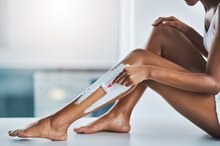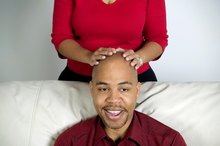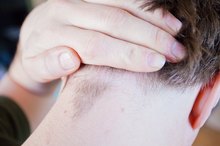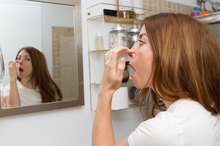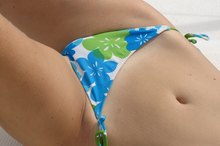Home Treatment for Vaginal Ingrown Hairs
Ingrown hairs in the vaginal area are uncomfortable, unsightly and, unfortunately, quite common 1. An ingrown vaginal hair can usually be treated at home with an over-the-counter topical acne medication. However, if the hair follicle appears infected or if you get ingrown hairs often, visit your doctor 1.
If you are experiencing serious medical symptoms, seek emergency treatment immediately.
Symptoms
An ingrown vaginal hair may cause a painful red bump that looks a lot like a pimple. There may be pus in the bump, but sometimes the bump may be hard instead of pus-filled. The bump may also itch. You may notice hyperpigmentation, which occurs when the affected area is slightly darker than the surrounding skin.
- An ingrown vaginal hair may cause a painful red bump that looks a lot like a pimple.
- You may notice hyperpigmentation, which occurs when the affected area is slightly darker than the surrounding skin.
Causes
Remedies for Vaginal Pimples
Learn More
Broken or bluntly cut pubic hair is the most common reason for ingrown vaginal hairs 1. When this happens, the hair may grow back at more of an angle and actually curl back into the skin rather than coming out of the hair follicle. When the hair penetrates your skin, the skin acts as if it is a foreign object and becomes inflamed.
Any type of hair removal including waxing, tweezing and shaving can cause ingrown hairs 1. This is especially true if shaving too close or at the wrong angle, or if the hairs are broken off rather than fully removed by tweezing or waxing.
Excess oil in the hair follicles and dry skin can also cause ingrown hairs, and people with coarse, curly or stiff hair tend to experience more ingrown hairs than people with soft, fine hair 1.
Read more: How to Treat an Infected Ingrown Hair
- Broken or bluntly cut pubic hair is the most common reason for ingrown vaginal hairs 1.
- Any type of hair removal including waxing, tweezing and shaving can cause ingrown hairs 1.
Treatments
The most important part of treating an ingrown hair is not to irritate it. Do not pluck, pick, squeeze or pop an ingrown hair pustule, which may cause an infection.
Apply a warm compress to the area three times a day for five to 10 minutes to encourage blood flow, which can promote healing.
Apply an over-the-counter topical acne treatment such as benzoyl peroxide at the first sign of an ingrown hair. This can help kill the bacteria that is growing under the skin. Be sure to wash the affected area and your hands with soap and water before applying the medication and let it soak in completely.
Keep the area clean and dry, wearing a panty liner if necessary. Aways shower after exercising, and wear loose-fitting clothing until the ingrown hair heals. Although exfoliation is recommended as a way to prevent ingrown hairs, you should not exfoliate if you currently have an ingrown hair 1.
- The most important part of treating an ingrown hair is not to irritate it.
- Apply a warm compress to the area three times a day for five to 10 minutes to encourage blood flow, which can promote healing.
Considerations
Symptoms of an Infected Ingrown Hair
Learn More
If you experience itching, you can apply hydrocortisone or another anti-itch medication to the area. If you do scratch at the area, apply an over-the-counter triple antibiotic ointment to the area to help minimize the risk of infection.
Experiencing recurring ingrown hairs when you don't shave or otherwise remove hair from your vaginal area could be a sign of another problem 1. Large, painful cysts may be mistaken for ingrown hairs, but can actually be caused by Staphylococcus or fungus and may require prescription antibiotics 1. Some sexually transmitted diseases can also cause lesions that resemble ingrown hairs 1. Speak to your doctor if you have any concerns about recurring ingrown hairs 1.
Read more: How to Treat Ingrown Hairs in the Pubic Area
- If you experience itching, you can apply hydrocortisone or another anti-itch medication to the area.
- Experiencing recurring ingrown hairs when you don't shave or otherwise remove hair from your vaginal area could be a sign of another problem 1.
Related Articles
References
- Epigee: Ingrown Hairs
- Palo Alto Medical Foundation: Pubic Hair Removal: Shaving
- MedlinePlus. Acne.
- Cleveland Clinic. Ingrown hair. Updated February 28, 2018.
- Merck Manuals. Ingrown beard hairs. Updated October 2019.
- Cleveland Clinic. Ingrown hair: Management and treatment. Updated February 28, 2018.
- Ogunbiyi A. Pseudofolliculitis barbae; current treatment options. Clin Cosmet Investig Dermatol. 2019;12:241-247. doi:10.2147/CCID.S149250
- MedlinePlus. Folliculitis. Updated October 8, 2018.
- Zaenglein AL, Pathy AL, Schlosser BJ, Alikhan A, Baldwin HE, et. al. Guidelines of care for the management of acne vulgaris. Journal of the American Academy of Dermatology. 2016; 74(5): 945-73. doi:10.1016/j.jaad.2015.12.037
Writer Bio
Casey Holley is a medical writer who began working in the health and fitness industries in 1995, while still in high school. She has worked as a nutrition consultant and has written numerous health and wellness articles for various online publications. She has also served in the Navy and is pursuing a Bachelor of Science in health administration from the University of Phoenix.

